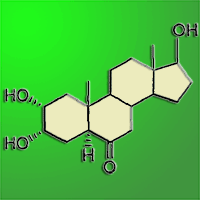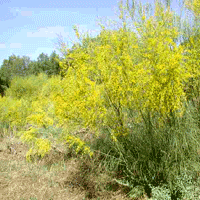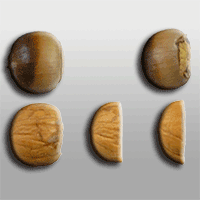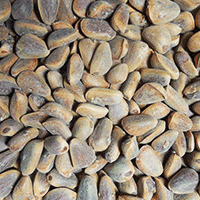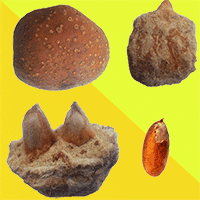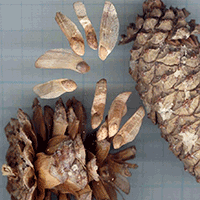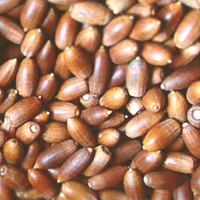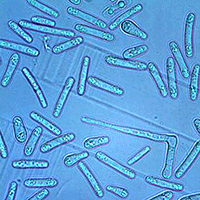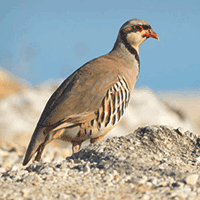Seeds of forest species can show germination and survival problems if they are exposed to adverse climatic conditions in the course of germination. Brassinosteroids could help seeds to overcome such environmental stress. We tested the effects of exogenous application of a chosen brassinosteroid compound 2α,3α,17β-trihydroxy-5α-androstan-6-one on the germination capacity and germination energy of European black pine (Pinus nigra J. F. Arnold) seeds. Before germination, the seeds were soaked for 24 hours either in demineralised water (control treatment) or in brassinosteroid solutions of four concentrations (high, higher-medium, lower-medium and low-concentration treatments). In the course of germination, the control and all four concentration treatments were subjected to two alternative temperature regimes: the optimal (unstressed) regime (20/30°C) and the stress regime, during which the seeds were exposed to temporary temperature stress (peaking at 42°C). In the optimal temperature regime, the highest germination energy was recorded in the higher-medium-concentration treatment and a significantly increased germination energy when compared to the control was also observed in a high-concentration treatment. The brassinosteroid, when applied in high, higher-medium and lower-medium concentrations, significantly increased the germination capacity compared to the control. The highest germination capacity was recorded in the high-concentration treatment. The temperature stress substantially reduced the germination of P. nigra. In the stress regime, the seeds of the higher-medium-concentration treatment decidedly showed the highest germination energy and capacity and those of the control treatment the lowest. The seed germination energy in the control was significantly lower than that recorded in the high and higher-medium-concentration treatments. The seed germination capacity in the control was significantly lower than those found in all concentration treatments, except for the seeds in the low-concentration treatment. The brassinosteroid application promoted the germination of black pine and partly alleviated the impact of the temporary heat stress. However, this application did not compensate for the heat stress effects completely. The potential for the use of the brassinosteroid may exist chiefly for seedings of Pinus nigra in forest nurseries where the nursery staff try to maintain optimal climatic conditions, and deviations from these conditions are usually only temporary.
Keywords
, , , ,
Citation
Suraweera PACNB, Kuneš I, Baláš M, Podrázský V, Šulitka M, Remeš J (2024). Use of brassinosteroids to overcome unfavourable climatic effects on seed germination in Pinus nigra J. F. Arnold. iForest 17: 1-9. - doi: 10.3832/ifor4340-016
Academic Editor
Michele Carbognani
Paper history
Received: Mar 01, 2023
Accepted: Nov 07, 2023
First online: Feb 02, 2024
Publication Date: Feb 29, 2024
Publication Time: 2.90 months
© SISEF - The Italian Society of Silviculture and Forest Ecology 2024
Open Access
This article is distributed under the terms of the Creative Commons Attribution-Non Commercial 4.0 International (https://creativecommons.org/licenses/by-nc/4.0/), which permits unrestricted use, distribution, and reproduction in any medium, provided you give appropriate credit to the original author(s) and the source, provide a link to the Creative Commons license, and indicate if changes were made.

Breakdown by View Type
(Waiting for server response...)
Article Usage
Total Article Views: 16179
(from publication date up to now)
Breakdown by View Type
HTML Page Views: 11462
Abstract Page Views: 1972
PDF Downloads: 2435
Citation/Reference Downloads: 2
XML Downloads: 308
Web Metrics
Days since publication: 697
Overall contacts: 16179
Avg. contacts per week: 162.49
Article Citations
Article citations are based on data periodically collected from the Clarivate Web of Science web site
(last update: Mar 2025)
(No citations were found up to date. Please come back later)
Publication Metrics
by Dimensions ©
Articles citing this article
List of the papers citing this article based on CrossRef Cited-by.
(1)
Agresti A, Bini M, Bertaccini B, Ryu E (2008)Simultaneous confidence intervals for comparing binomial parameters. Biometrics 64: 1270-1275.
CrossRef |
Gscholar
(2)
Ahammed GJ, Li X, Liu A, Chen S (2020)Brassinosteroids in plant tolerance to abiotic stress. Journal of Plant Growth Regulation 39 (4): 1451-1464.
CrossRef |
Gscholar
(3)
Angevine MW, Chabot BF (1979)Seed germination syndromes in higher plants. In: “Topics in Plant Population Biology” (Solbrig OT, Jain S, Johnson GB, Raven PH eds). Macmillan Education, London, UK, pp. 188-206.
CrossRef |
Gscholar
(4)
Ayan S, Yucedag C, Simovski B (2021)A major tool for afforestation of semi-arid and anthropogenic steppe areas in Turkey: Pinus nigra J. F. Arnold subsp. pallasiana (Lamb) Holmboe. Journal of Forest Science 67 (10): 449-463.
CrossRef |
Gscholar
(5)
Bajguz A, Hayat S (2009)Effects of brassinosteroids on the plant responses to environmental stresses. Plant Physiology and Biochemistry 47: 1-8.
CrossRef |
Gscholar
(6)
Booner T (2008)Seed biology. In: “The Woody Plant Seed Manual” (Booner T, Karrfalt RP eds). Agricultural Handbook 727, USDA Forest Service, Washington, DC, USA, pp. 1-38.
Gscholar
(7)
Choudhary PS, Yu J-Q, Yamaguchi-Shinozaki K, Kazuo S, Tran L-SP (2012)Benefits of brassinosteroid crosstalk. Trends in Plant Science 10: 594-605.
CrossRef |
Gscholar
(8)
Cui L, Zou Z, Zhang J, Zhao Y, Yan F (2016)24-Epibrassinoslide enhances plant tolerance to stress from low temperatures and poor light intensities in tomato (
Lycopersicon esculentum Mill.). Functional and Integrative Genomics 16 (1): 29-35.
CrossRef |
Gscholar
(9)
Cukor J, Rasakova NM, Linda R, Linhart L, Gutsch MR, Kunes I (2018)Effects of brassinosteroid application on seed germination of Scots pine under standard and heat stress conditions. Baltic Forestry 24 (1): 60-67.
Gscholar
(10)
Deligoz A, Bayar E, Genz M, Karatep Y (2021)Differences in water relations and total carbohydrate content between precommercially thinned
Pinus nigra subsp.
pallasiana stands. Journal of Forest Science 67 (3): 125-133.
CrossRef |
Gscholar
(11)
Dias A, Carvalho A, Silva ME, Lima-Brito J, Gaspar MJ, Alves A, Rodrigues JC, Pereira F, Morais J, Lousada JL (2020)Physical, chemical and mechanical wood properties of
Pinus nigra growing in Portugal. Annals of Forest Science 77 (3): 72-82.
CrossRef |
Gscholar
(12)
Divi UK, Rahman T, Krishna P (2010)Brassinosteroid-mediated stress tolerance in
Arabidopsis shows interactions with abscisic acid, ethylene and salicylic acid pathways. BMC Plant Biology 10: 151.
CrossRef |
Gscholar
(13)
Donohue K, De Casas RR, Burghardt L, Kovach K, Willis CG (2010)Germination, postgermination adaptation, and species ecological ranges. Annual Review of Ecology, Evolution, and Systematics 41: 293-319.
CrossRef |
Gscholar
(14)
Fàbregas N, Lozano-Elena F, Blasco-Escámez D, Tohge T, Martínez-Andújar C, Albacete A, Osorio S, Bustamante M, Riechmann JL, Nomura T, Yokota T, Conesa A, Alfocea FP, Fernie AR, Caño-Delgado AI (2018)Overexpression of the vascular brassinosteroid receptor BRL3 confers drought resistance without penalizing plant growth. Nature Communications 9 (1): 4680.
CrossRef |
Gscholar
(15)
Gallo J, Baláš M, Linda R, Kuneš I (2017)Growth performance and resistance to ground late frosts of
Fagus sylvatica L. plantation treated with a brassinosteroid compound. Journal of Forest Science 63: 117-125.
CrossRef |
Gscholar
(16)
Heinze M (1996)Standorte, Ernährung und Wachstum der Schwarzkiefer (
Pinus nigra Arnold) [Sites, nutrition and growth of Black Pine (
Pinus nigra Arnold)]. Forstwissenschaftliches Centralblatt vereinigt mit Tharandter forstliches Jahrbuch 115 (1): 17-35. [in German]
CrossRef |
Gscholar
(17)
Ibañez C, Delker C, Martinez C, Bürstenbinder K, Janitza P, Lippmann R, Ludwig W, Sun H, James GV, Klecker M, Grossjohann A, Schneeberger K, Prat S, Quint M (2018)Brassinosteroids Dominate Hormonal Regulation of Plant Thermomorphogenesis via BZR1. Current Biology 28 (2): 303-310.
CrossRef |
Gscholar
(18)
ISTA (2015)International rules for seed testing. International Seed Testing Association (ISTA), vol 2015, Bassersdorf, Switzerland, pp. 276.
Gscholar
(19)
Jin SH, Li XQ, Wang GG, Zhu XT (2015)Brassinosteroids alleviate high-temperature injury in
Ficus concinna seedlings
via maintaining higher antioxidant defence and glyoxalase systems. AoB Plants 7: 1-15.
CrossRef |
Gscholar
(20)
Khripach V, Zhabinskii V, De Groot A (2000)Twenty years of brassinosteroids: steroidal plant hormones warrant better crops for the XXI century. Annals of Botany 86 (3): 441-447.
CrossRef |
Gscholar
(21)
King A, Karoly D (2017)Climate extremes in Europe at 1.5 and 2 degrees of global warming. Environmental Research Letters 12: 114031.
CrossRef |
Gscholar
(22)
Kohout L, Kasal A, Chodounská H, Slavíková B, Hniličková J (2003)The use of 2α,3α,17β-trihydroxy-5α-androstan-6-one as active ingredient for plant development regulation. Patent International Publication no. WO 03/003834 A1, Application Number PCT/CZ2002/000041, World Intellectual Property Organisation, International Bureau, Geneva, Switzerland, pp. 17.
Gscholar
(23)
Kuneš I, Baláš M, Linda R, Gallo J, Nováková O (2017)Effects of brassinosteroid application on seed germination of Norway spruce, Scots pine, Douglas fir and English oak. iForest - Biogeosciences and Forestry 10 (1): 121-127.
CrossRef |
Gscholar
(24)
Li J, Chory J (1997)A putative leucine-rich repeat receptor kinase involved in brassinosteroid signal transduction. Cell 90 (5): 929-938.
CrossRef |
Gscholar
(25)
Li K-R, Zhang S, He X (2002)Effect of natural brassinolide on germination of
Pinus tabulaeformis and
Robinia pseudoacacia seeds. Scientia Silvae Sinicae 38 (6): 150-153.
Gscholar
(26)
Li K-R, Zhang W-B, Li H-K (2005)Effect of natural brassinolide on germination of
Ailanthus altissima. Seeds Forestry Studies in China 7 (2): 12-14.
CrossRef |
Gscholar
(27)
Li KR, Wang HH, Han G, Wang QJ, Fan J (2008)Effects of brassinolide on the survival, growth and drought resistance of
Robinia pseudoacacia seedlings under water-stress. New Forests 35: 255-266.
CrossRef |
Gscholar
(28)
Lloret F, Peñuelas J, Estiarte M (2005)Effects of vegetation canopy and climate on seedling establishment in Mediterranean shrubland. Journal of Vegetation Science 16 (1): 67-76.
CrossRef |
Gscholar
(29)
Lorenz R, Stalhandske Z, Fischer EM (2019)Detection of a climate change signal in extreme heat, heat stress, and cold in Europe from observations. Geophysical Research Letters 46 (14): 8363-8374.
CrossRef |
Gscholar
(30)
Maguire JD (1962)Speed of germination - aid in selection and evaluation for seedling emergence and vigor. Crop Science 2 (2): 176-177.
CrossRef |
Gscholar
(31)
Mandava NB (1988)Plant growth-promoting brassinosteroids. Annual Review of Plant Physiology and Plant Molecular Biology 39 (1): 23-52.
CrossRef |
Gscholar
(32)
Manghwar H, Hussain A, Ali Q, Liu F (2022)Brassinosteroids (BRs) role in plant development and coping with different stresses. International Journal of Molecular Sciences 23 (3): 1012.
CrossRef |
Gscholar
(33)
Mataruga M, Haase DL, Isajev V (2010)Dynamics of seed imbibition and germination of Austrian pine (
Pinus nigra Arnold) from extreme habitat conditions within five Balkan provenances. New Forests 40 (2): 229-242.
CrossRef |
Gscholar
(34)
Mazorra LM, Holton N, Bishop GJ, Núñez M (2011)Heat shock response in tomato brassinosteroid mutants indicates that thermotolerance is independent of brassinosteroid homeostasis. Plant Physiology and Biochemistry 49 (12): 1420-1428.
CrossRef |
Gscholar
(35)
McDonald SE (1984)Irrigation in forest-tree nurseries: monitoring and effects on seedling growth. In: “Forest Nursery Manual: Production of Bareroot Seedlings” (Duryea ML, Landis TD eds). Martinus Nijhoff/Dr W. Junk Publishers for Forest Research Laboratory, Oregon State University, Corvallis, Hague/Boston/Lancaster, pp. 107-121.
Gscholar
(36)
Morales M, Munné-Bosch S (2019)Malondialdehyde: facts and artifacts. Plant Physiology 180 (3): 1246-1250.
CrossRef |
Gscholar
(37)
Nawaz F, Naeem M, Zulfiqar B, Akram A, Ashraf MY, Raheel M, Shabbir RN, Hussain RA, Anwar I, Aurangzaib M (2017)Understanding brassinosteroid-regulated mechanisms to improve stress tolerance in plants: a critical review. Environmental Science and Pollution Research 24 (19): 15959-15975.
CrossRef |
Gscholar
(38)
Nolan T, Chen J, Yin Y (2017)Cross-talk of Brassinosteroid signaling in controlling growth and stress responses. Biochemical Journal 474 (16): 2641-2661.
CrossRef |
Gscholar
(39)
Nolan TM, Vukašinović N, Liu D, Russinova E, Yin Y (2020)Brassinosteroids: multidimensional regulators of plant growth, development, and stress responses. Plant Cell 32 (2): 295-318.
CrossRef |
Gscholar
(40)
Nováková O, Kuneš I, Gallo J, Baláš M (2014)Effects of brassinosteroids on prosperity of Scots pine seedlings. Journal of Forest Science 60 (9): 388-393.
CrossRef |
Gscholar
(41)
Nováková O, Gallo J, Baláš M, Spulak O, Kuneš I (2015)Vliv brassinosteroidu na výškový prírust, fluorescenci chlorofylu a mortalitu sazenic smrku ztepilého a borovice lesní v podmínkách lesní školky [Influence of brassinosteroids on height increment, chlorophyll fluorescence and mortality of seedlings of Norway spruce and Scots pine in forest nursery conditions]. Zprávy Lesnického Výzkumu 60 (2): 122-129. [in Czech]
Gscholar
(42)
Planas-Riverola A, Gupta A, Betegón-Putze I, Bosch N, Ibañes M, Caño-Delgado AI (2019)Brassinosteroid signaling in plant development and adaptation to stress. Development 146 (5): dev151894.
CrossRef |
Gscholar
(43)
Probert RJ (2000)The role of temperature in the regulation of seed dormancy and germination. In: “Seeds: the Ecology of Regeneration in Plant Communities (2nd edn)” (Fenner M ed). CAB International, Wallingford, UK, pp. 261-292.
CrossRef |
Gscholar
(44)
Procházka P, Stranc P, Kupka I, Stranc J, Pazderu K (2015)Forest seed treatment with brassinosteroids to increase their germination under stress conditions. Journal of Forest Science 61 (7): 291-296.
CrossRef |
Gscholar
(45)
Pullman GS, Zhang Y, Phan BH (2003)Brassinolide improves embryogenic tissue initiation in conifers and rice. Plant Cell Reports 22 (2): 96-104.
CrossRef |
Gscholar
(46)
Rönsch GA, Matschke J, Schachler G (1993)Influence of (22S,23S)-homobrassinolide on rooting capacity and survival of adult Norway spruce cuttings Tree Physiology 12: 71-80.
CrossRef |
Gscholar
(47)
Sadura I, Janeczko A (2018)Physiological and molecular mechanisms of brassinosteroid-induced tolerance to high and low temperature in plants. Biologia Plantarum 62 (4): 601-616.
CrossRef |
Gscholar
(48)
Sadura I, Pociecha E, Dziurka M, Oklestkova J, Novak O, Gruszka D, Janeczko A (2019)Mutations in the HvDWARF, HvCPD and HvBRI1 genes-involved in brassinosteroid biosynthesis/ signalling: altered photosynthetic efficiency, hormonal homeostasis and tolerance to high/low temperatures in barley. Journal of Plant Growth Regulation 38 (3): 1062-1081.
CrossRef |
Gscholar
(49)
San-Miguel-Ayanz J, De Rigo D, Caudullo G, Houston Durrant T, Mauri A (2016)European atlas of forest tree species. Publication Office of the European Union, Luxembourg, pp. 197.
Gscholar
(50)
Siegel S, Castellan JN (1988)Nonparametric statistics for the behavioral sciences (2nd edn). McGraw-Hill, New York, USA, pp. 399.
Gscholar
(51)
Steber CM, McCourt P (2001)A role for brassinosteroids in germination in
Arabidopsis. Plant Physiology 125 (2): 763-769.
CrossRef |
Gscholar
(52)
Suraweera C, Balas M, Gallo J, D’Andrea G, Vacek S, Remes J (2023)Intensive initial care of silver fir using improving compounds: a way to support diverse forests? Journal of Forest Science 69 (5): 179-192.
CrossRef |
Gscholar
(53)
Thussagunpanit J, Jutamanee K, Kaveeta L, Chai-arree W, Pankean P, Homvisasevongsa S, Suksamrarn A (2015)Comparative effects of brassinosteroid and brassinosteroid mimic on improving photosynthesis, lipid peroxidation, and rice seed set under heat stress. Journal of Plant Growth Regulation 34 (2): 320-331.
CrossRef |
Gscholar
(54)
Twardosz R, Kossowska-Cezak U (2021)Large-area thermal anomalies in Europe (1951-2018). Temporal and spatial patterns. Atmospheric Research 251: 105434.
CrossRef |
Gscholar
(55)
Twardosz R, Walanus A, Guzik I (2021)Warming in Europe: recent trends in annual and seasonal temperatures. Pure and Applied Geophysics 178 (10): 4021-4032.
CrossRef |
Gscholar
(56)
Vallauri DR, Aronson J, Barbero M (2002)an analysis of forest restoration 120 years after reforestation on badlands in the Southwestern Alps. Restoration Ecology 10 (1): 16-26.
CrossRef |
Gscholar
(57)
Wei Z, Li J (2020)Regulation of brassinosteroid homeostasis in higher plants. Frontiers in Plant Science 11.
CrossRef |
Gscholar
(58)
Zhang YP, He J, Yang SJ, Chen YY (2014)Exogenous 24-epibrassinolide ameliorates high temperature-induced inhibition of growth and photosynthesis in
Cucumis melo. Biologia Plantarum 58 (2): 311-318.
CrossRef |
Gscholar


